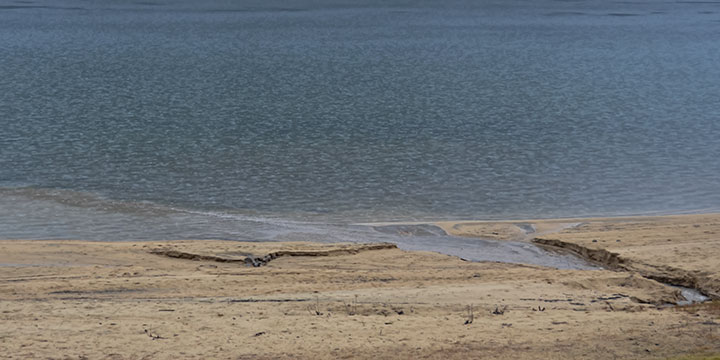Two months ago, in winter tranquility, I noted that most treatments of the seasonal changes of beaches consider only those around oceans or flatland lakes, but ignore the rather different behaviour of mountain lakes.
At the risk of whingeing, this posting picks up on that theme and considers the source of the sand. A way to assess the problem that might be faced by a local science teacher is that authoritative sources on beach formation, such as Wikipedia, says that:
Beaches are the result of wave action…. Beach materials come from erosion of rocks offshore, as well as from headland erosion…
So, the claim is that waves pound the shoreline and break up rocks and headland into small particles that then form our beaches. Alas, that just does not seem to describe what happens around here. Rather, it is the many creeks flowing into our Lake that carry the sand that produces the beaches, each of which sits in the vicinity of a creek mouth.
A mountain creek scours its bed. It certainly smashes rocks creating fragments, but then transports smaller particles downstream to the Lake. It is this debris that forms our beaches.
Mind you, once this sediment arrives, waves move it along the shore by a process that is referred to as longshore drift. However, the source of the sand is not the bashing of that shoreline by waves (which are rather small anyway), but the deposition of the multitudinous creeks that flow into the Lake. It is during the spring freshet that creeks transport most of the sand that gets added to beaches. But, any significant rainfall will swell creeks and do likewise, as is seen in the picture, below.
This tiny creek is one of hundreds that transport sand down the mountainside to the Lake and then spread it along the shore to create our beaches.


I always learn something from your posts, Alistair. Today, I had to look up the meaning of whingeing.
B, chuckle, and I thought I was treating the development of beaches, not vocabulary. Actually, I suspect there are many occasions where the word, whinge, might find good use.
This time of year the creek bottom at Kokanee Creek is relatively dark; the sand is mixed with organic matter. Soon, when the spring flow starts you will be able to see the lighter colored sand washed from higher upstream cover the darker bottom. Two springs ago there was a clear demarcation, a line that advanced downstream. It took a couple of days to move from the bottom of the rapids to the mouth of the creek, changing the color of the creek bottom.